VOL.1 S T U D I O S PYTHON BTECH 3RD YEAR UNIT 1 TO UNIT 5 35 PAGES
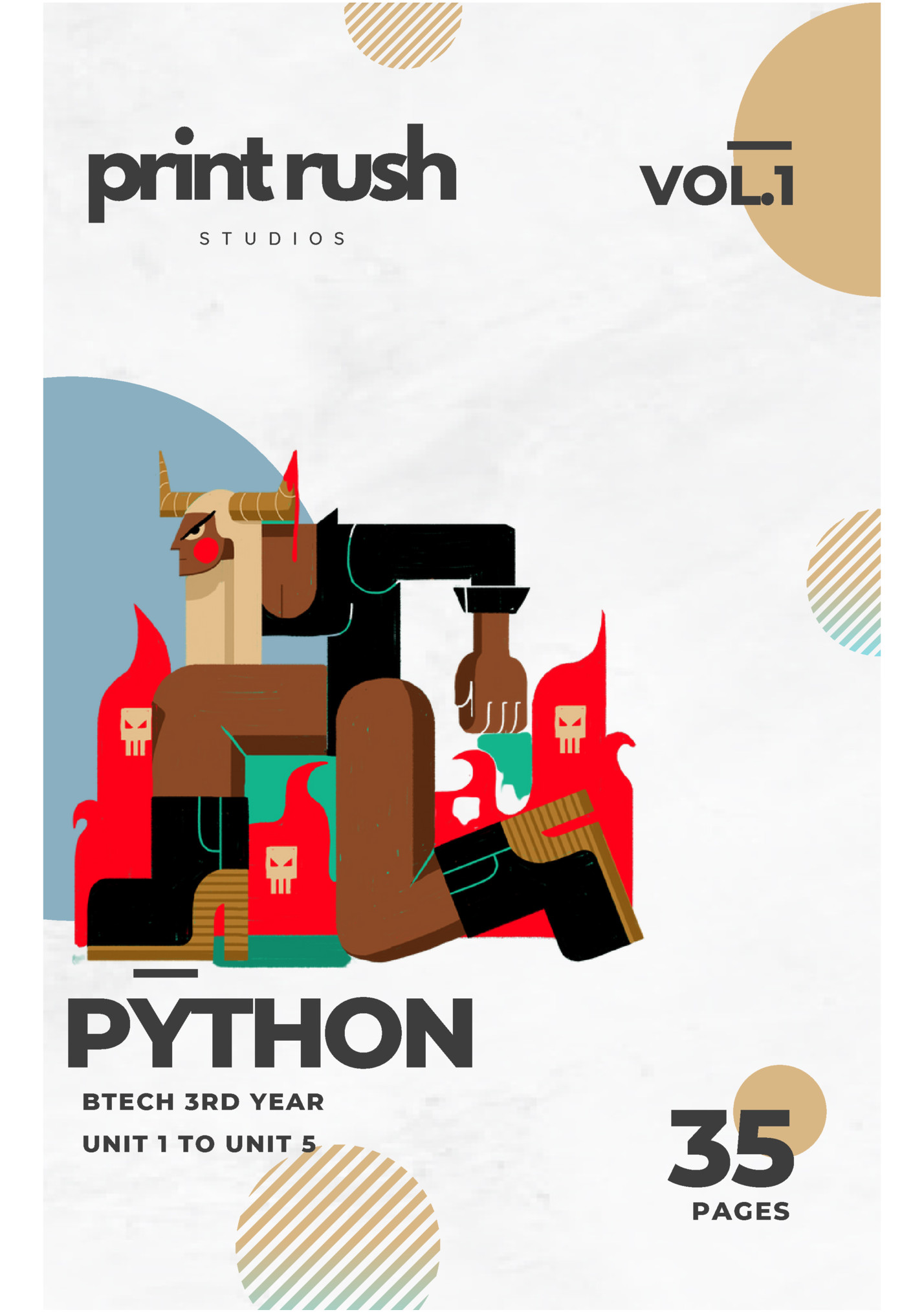
Python/Unit-1 Unit-1 Basic Introduction Syllabus- Introduction to Python, History, Features, command interpreter and development environment-IDLE, Application of Python, Python 2/3 differences, Basic program structure, quotation and indentation, Operator, Basic data types and In-built objects Introduction to Python [End Sem BCA -2018 2M] Python is a high-level, interpreted programming language known for its readability and simplicity. Python is designed to be easy to learn and emphasizes code readability, which makes it an excellent choice for beginners and professionals alike. History Of Python Python, created by Guido van Rossum in the late 1980s, saw its first release in 1991. Notable milestones include Python 2.0 in 2000, Python 3.0 in 2008 for enhanced consistency, and the official end of Python 2 support in 2020. Its community-driven development, exemplified by Guido van Rossum's transition from BDFL in 2018, contributes to its ongoing success. Python's evolution showcases its journey from a holiday project to a globally influential programming language with a rich ecosystem. Features 1. Readability: Python's syntax is clean and easy to read, which reduces the cost of program maintenance and development. 2. Interpreted and Interactive: Python is an interpreted language, which means that the source code is executed line by line by the Python interpreter. 3. Object-Oriented: Python supports object-oriented programming (OOP) principles, facilitating the creation and usage of classes and objects. 4. Dynamically Typed: Python is dynamically typed, meaning that you don't need to specify the data type of a variable explicitly 5. Extensive Standard Library: Python comes with a large standard library that supports many common programming tasks 6. Cross-Platform: Python is compatible with major operating systems, such as Windows, macOS, and Linux. This cross-platform nature contributes to its popularity for both desktop and server-side development. 7. Versatility: Python is a versatile language used in various domains, including web development (Django, Flask), data science (NumPy, pandas), machine learning (TensorFlow, PyTorch), automation, scripting, and more. 8. Community and Ecosystem: Python has a vibrant and active community of developers. The Python Package Index (PyPI) hosts a vast collection of third-party libraries and frameworks that extend Python's capabilities, making it suitable for various domains, including web development, data science, artificial intelligence, machine learning, and more. Command interpreter and development environment-IDLE IDLE stands for "Integrated Development and Learning Environment" 1
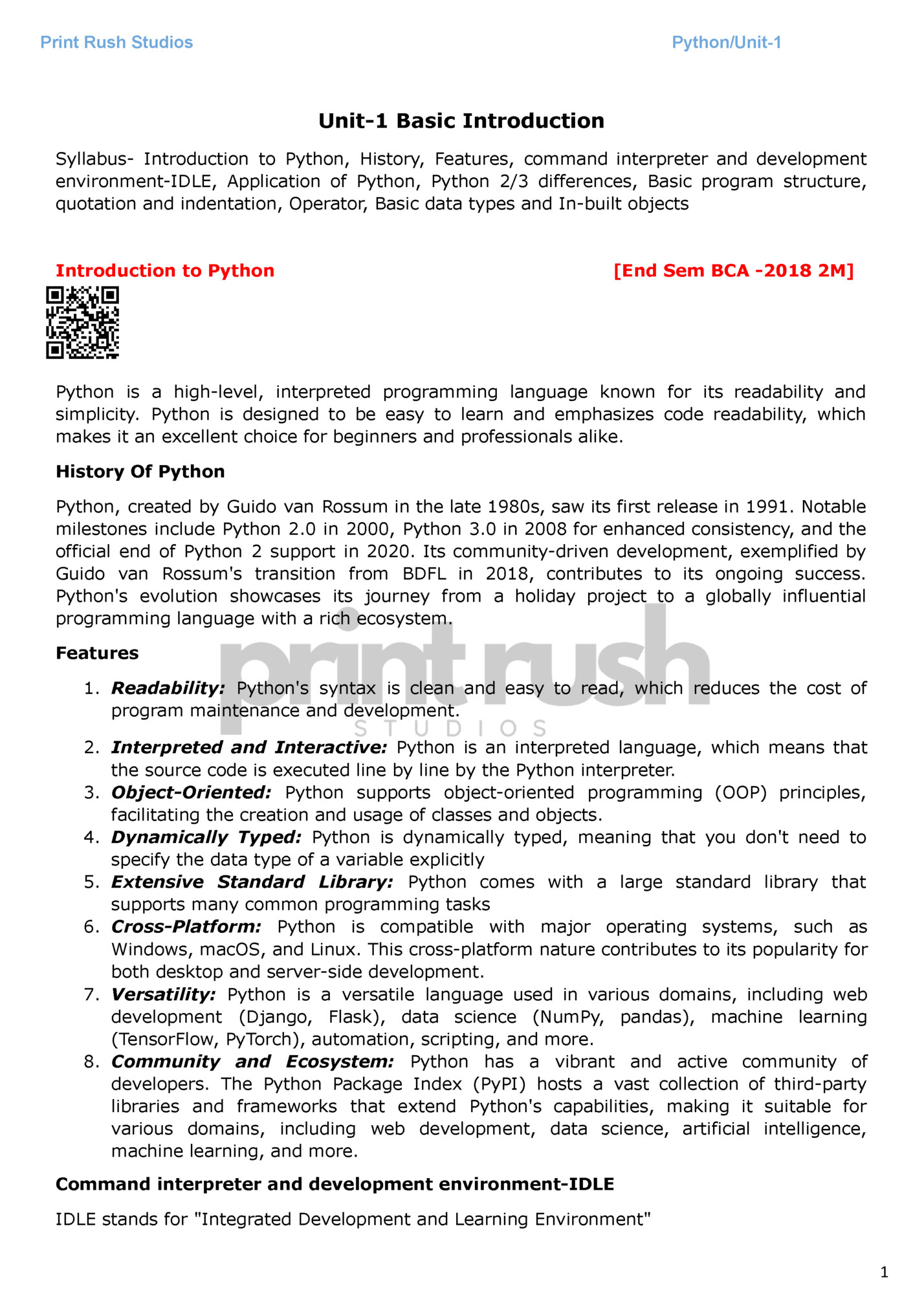
Python/Unit-1 It comes bundled with the standard Python distribution and provides a convenient way for 2

Python/Unit-1 users to interact with Python code. Its simple interface and integrated features facilitate a smooth introduction to the language. It provides a straightforward and accessible environment for writing, testing, and learning Python code Its dual functionalities include: 1. Command Interpreter (Shell): IDLE includes a Python Shell where you can interactively enter Python commands. This shell acts as a command-line interface, allowing users to test and execute Python code snippets line by line. It provides immediate feedback, making it an excellent tool for experimenting with Python commands and exploring language features. 2. Development Environment (Script Editor):IDLE offers a script editor. This integrated editor allows users to write, edit, and save Python scripts. It supports features such as syntax highlighting, code completion, and indentation management, enhancing the overall development experience. Applications of Python 1. Web Development: Frameworks like Django and Flask: Python is widely used for building dynamic and scalable web applications. 2. Data Science and Machine Learning: NumPy, pandas, Scikit-learn, TensorFlow, PyTorch: Python is a leading choice for data analysis, machine learning, and artificial intelligence applications. 3. Scientific Computing: SciPy, Matplotlib: Python is used in scientific research and engineering for tasks such as numerical computing, data visualization, and simulation. 4. Automation and Scripting: Scripting for System Administration: Python is employed for automating repetitive tasks, system administration, and writing scripts. 5. Game Development: Pygame: Python is used for developing 2D games, prototyping, and game scripting. 6. Desktop GUI Applications: Tkinter, PyQt, Kivy: Python can be used to create desktop applications with graphical user interfaces (GUIs). 7. Databases: SQLAlchemy, Django ORM: Python is used for database management, integrating with databases like MySQL, PostgreSQL, and SQLite. 8. Network Programming: Socket programming: Python is suitable for writing networking applications and scripts. 9. Cybersecurity: Security tools and scripts: Python is used for developing security-related tools and scripts. 3
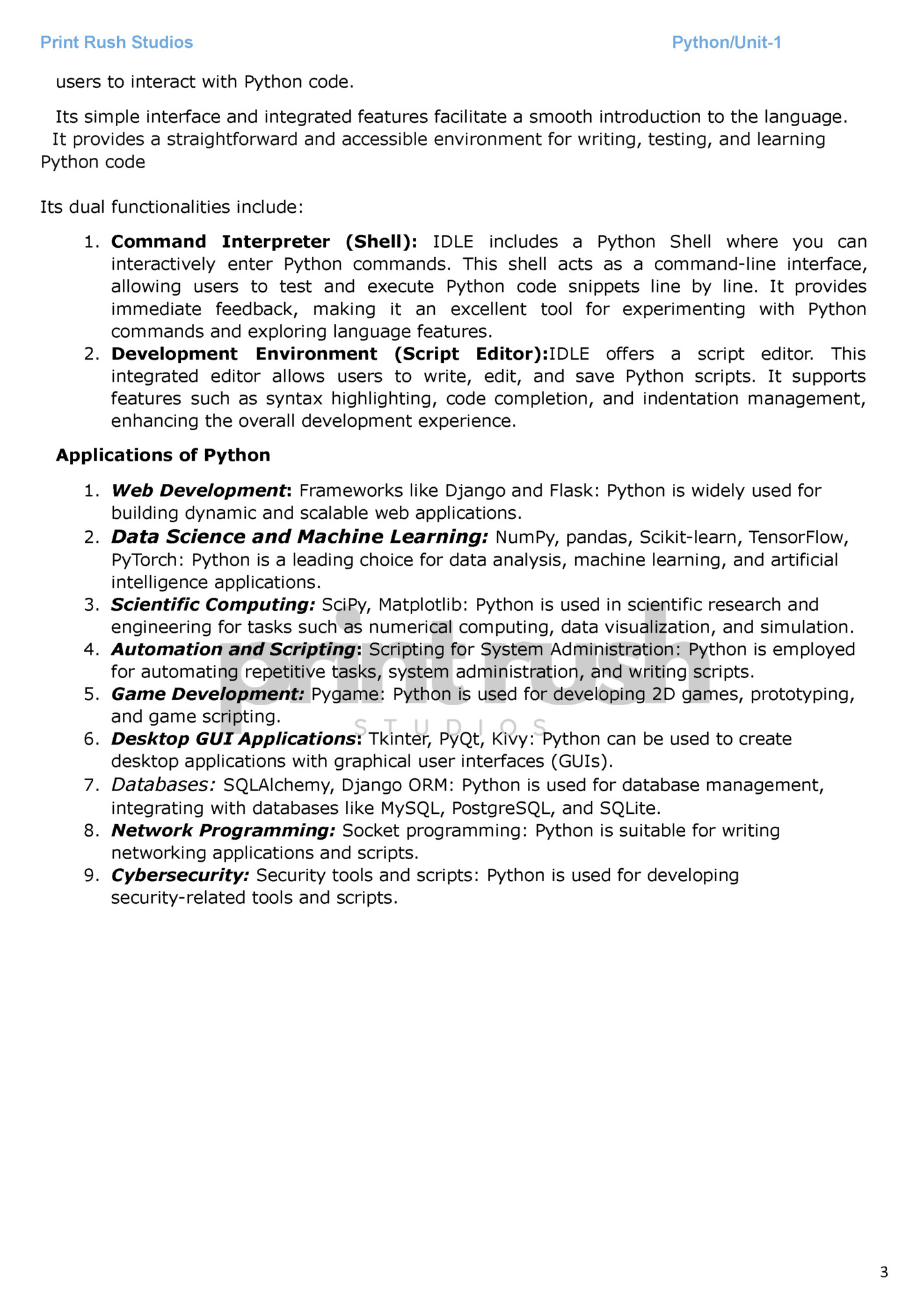
Python/Unit-1 Python 2/3 differences Python 2 Python 2 was released in the year 2000. In Python 2, print is considered to be a statement and not a function. In Python 2, strings are stored as ASCII by default. In Python 2, exceptions are enclosed in notations. [End Sem BCA -2018 3M] Python 3 Python 3 was released in the year 2008. In Python 3, print is considered to be a function and not a statement. In Python 3, strings are stored as UNICODE by default. In Python 3, exceptions are enclosed in parentheses. Python 2 has more complicated syntax than Python 3. Python 2 is no longer in use since 2020. Python 3 has an easier syntax compared to Python 2. Python 3 is more popular than Python 2 and is still in use in today’s times. Python 2 codes can be ported to Python 3 with a lot of effort. In Python 2, the xrange() function has been defined for iterations. Python 3 is not backward compatible with Python 2. In Python 3, the new Range() function was introduced to perform iterations. 4
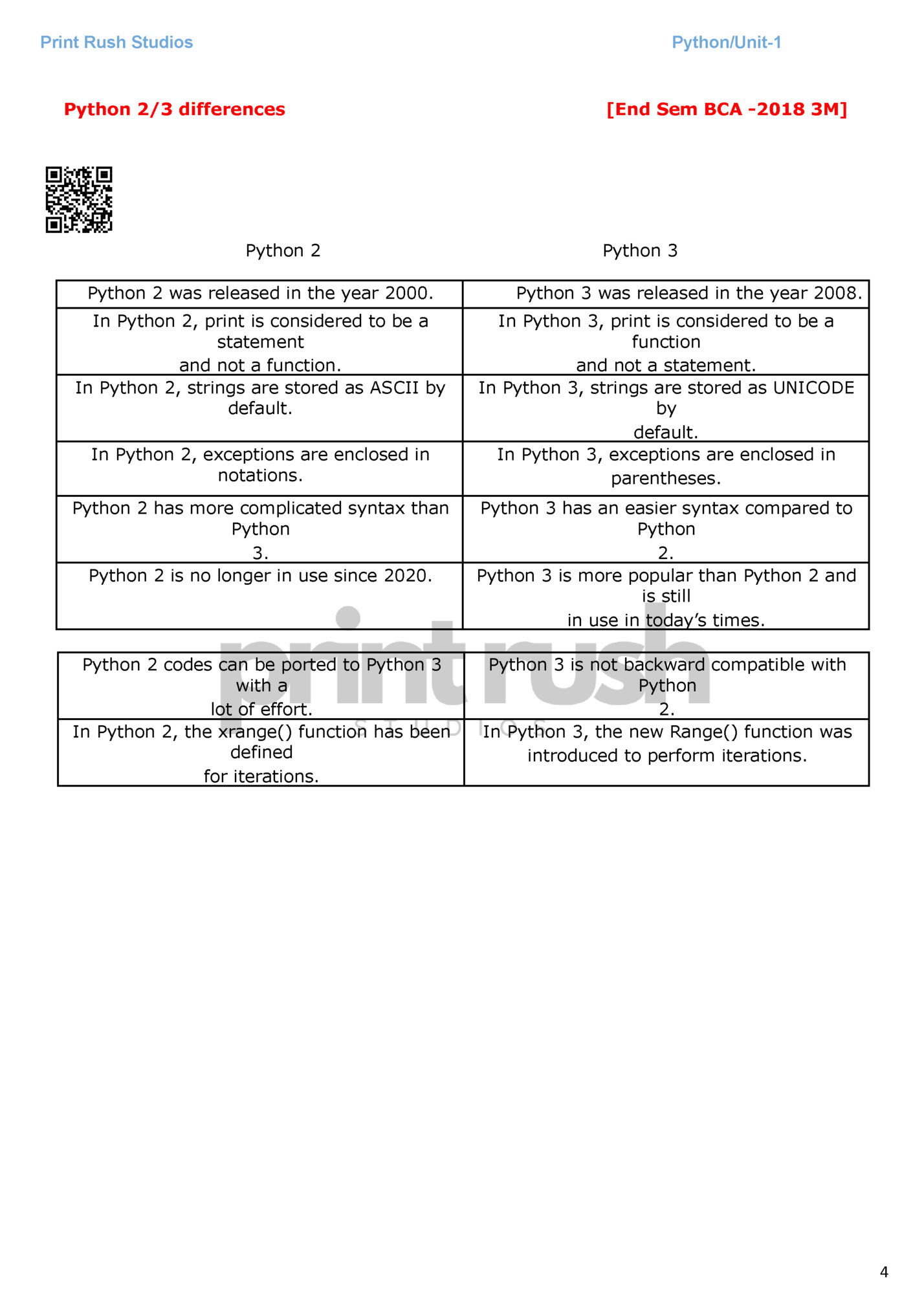
Python/Unit-1 Basic program structure 1. Comments: Single-line comments start with #, and multi-line comments use triple-quotes (''' or """). They are for explanatory notes and are ignored during execution. 2. Docstring: Triple-quoted strings at the beginning of a module, class, or function are used for documentation. They are optional but good practice. 3. Import Statements: Used to bring in external modules or libraries. These statements are optional but common. 4. Function Definitions: Define functions using the def keyword. Functions are blocks of reusable code. The return statement is used to return a value from a function. 5

Python/Unit-1 Quotation and Indentation Quotation is used to define strings in Python, and indentation is used to define the structure and hierarchy of code blocks. Both are essential for writing clear and readable Python code. 1. Quotation: In Python, you can use either single (') or double (") quotes to define strings. triple single or triple double quotes are used for multiline strings: 2. Indentation: It refers to the spaces at the beginning of a code line. Python uses indentation to indicate a block of code. Python will give you an error if you skip the indentation [2019] Operators Operators in Python are special symbols or keywords used to perform operations on variables and values. They are crucial for building expressions and statements in a programming language. 1.Arithmetic Operators: Arithmetic operators perform basic mathematical operations. They are +, -, *, /, %, ** (exponentiation), // (floor division) 2. Comparison Operators: Comparison operators are used to compare values and return a Boolean result. They are ‘==’ Equal to, ‘!=’ Not equal to , < Less than , > Greater than , <= Less than or equal to , >= Greater than or equal to 3. Logical Operators: Logical operators perform logical operations and return a Boolean result. they are and Logical AND, or Logical OR , not Logical NO 4.Assignment Operators: Assignment operators are used to assign values to variables. they are =, +=, -=, *=, /=, %=, **=, //= 5. Bitwise Operators: Bitwise operators perform operations on individual bits of binary numbers. they are &, |, ^, ~, << (left shift), >> (right shift) 6. Membership Operators: Membership operators test for membership in a sequence (e.g., strings, lists, or tuples).They are 'in' , 'not in' 6
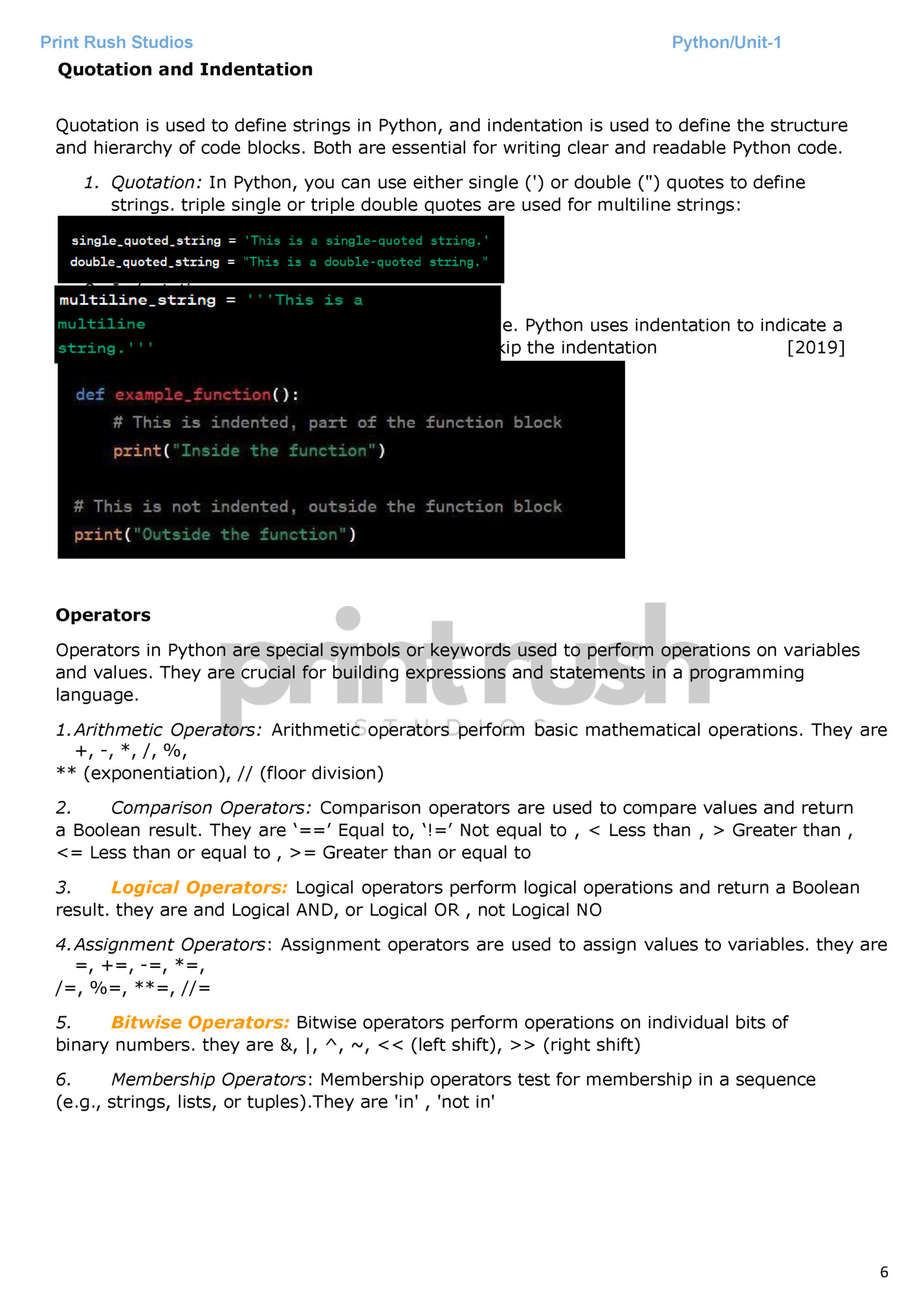
Python/Unit-1 Basic data types and In-built objects Python has several basic data types and built-in objects that form the foundation for data manipulation and storage. Basic Data Types: 1. int: Integer type represents whole numbers (e.g., 5, -10, 0). 2. float: Float type represents floating-point numbers or decimals (e.g., 3.14, -0.5). 3. str: String type represents text or sequences of characters enclosed in single or double quotes (e.g., "hello", 'Python'). 4. Bool: Boolean type represents the truth values “True” or “False”. 5. NoneType: The None type represents the absence of a value or a null value. In-built objects 1. List: A mutable, ordered sequence of elements. Lists can contain elements of different types and are defined using square brackets. Ex:- my_list = [1, 2, 'three', 4.0] 2. Tuple: An immutable, ordered sequence of elements. Tuples are defined using parentheses. Ex:- my_tuple = (1, 2, 'three', 4.0) 3. Set: An unordered collection of unique elements. Sets are defined using curly braces. Ex:- my_set = {1, 2, 'three', 4.0} 4. Dictionary (dict): A collection of key-value pairs. Dictionaries are defined using curly braces and colons. Ex:- my_dict = {'key1': 'value1', 'key2': 42, 'key3': [1, 2, 3]} 5. String (str): A sequence of characters. Strings can be manipulated using various methods and operators. Ex:- my_string = "Hello, Python!" 6. Boolean (bool): Represents truth values True or False. Often used in control flow and logical operations. Ex:- my_boolean = True 7. Integer (int) and Float (float): Numeric types used for integer and floating-point values. Ex:- my_integer = 42 my_float = 3.14 7
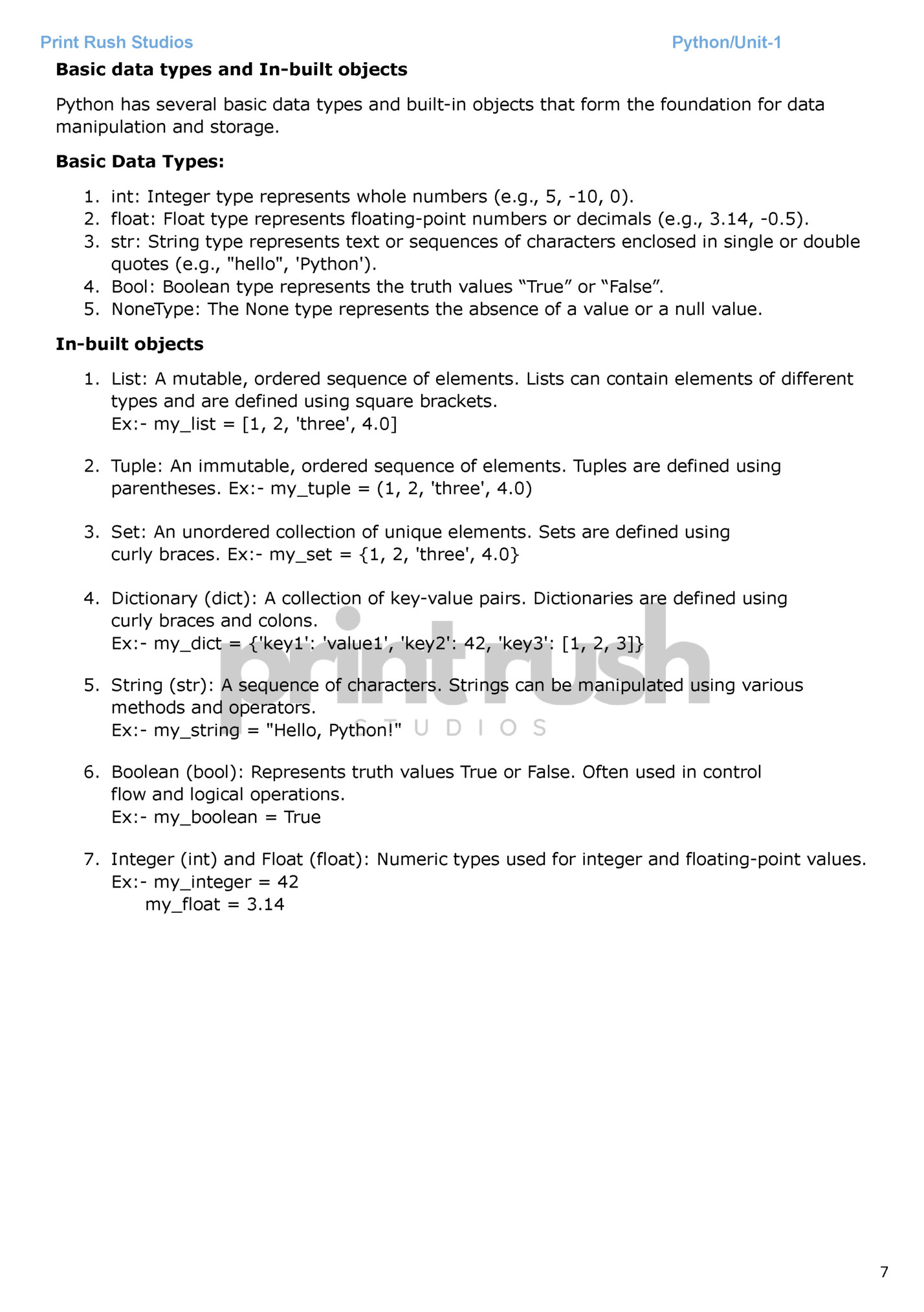
Python/Unit-1 To Access The Complete Printed Module, Delivered To The Comfort Of Your Homes Visit The Link -https://www.printrushstudios.online/purchase-modules https://wa.me/message/6TYFOEZULHEOI1 Or Whatsapp Us at - +91 92445 78723 For Single Module Any 1 Subject All Units Covered - ₹99 For Bundle Of All Subjects Covered Including Electives - ₹299 Orders Dispatching From Monday Onwards. 8

Fleepit Digital © 2021